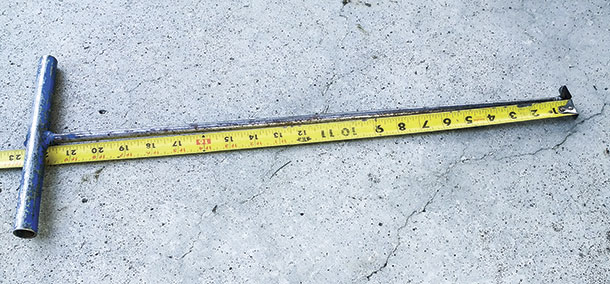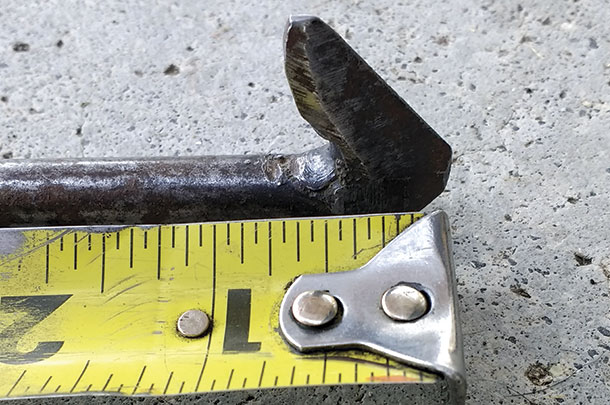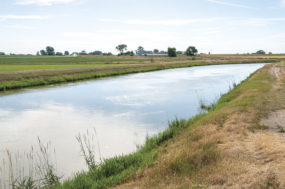Among the offerings in the store are several Native American items, from turquoise jewelry and belt buckles to blankets. There’s a selection of books with Old West and Native American themes, collector thimbles (one of the few things my wife collects, trying for one from each state) – and then the knife case.
There I spied a survival knife, the handle made of a wrapping of paracord, with a tanto-style blade tip and a section of the back of the blade made into a coarse-toothed area suitable for use as a saw.
I was caught in the act of drooling over it; Elli asked if I didn’t already have a knife. “Yes,” was my reply, “but not one exactly like this one.” She rolled her eyes. I got two – one for me and one for the grandson, who is also a bladed-instrument aficionado.
On the way through the Wyoming wind back to the pickup, she said it was OK for me to just like knives – and flashlights, which seem to multiply by themselves the same as pennies in the coin purse. Flashlights have been justified because the new one is smaller and brighter than the old one.
Once on the road, and having verified we were going east and not west on the freeway, she commented that at least I didn’t have boxes and boxes of lights for my vehicles stacked up like my hay-hauling son did. I asked how she knew that, and she said our daughter-in-law had commented about it once. Said he claimed they were for the truck or one of the trailers – as soon as he got time to install them.
I made the mistake of stating she just did not know where to look in my shop.
Elli is an avid reader. When she finishes a book she thoroughly enjoyed, she says she just can’t part with it; she knows that sometime later, she’ll want to read it again. And without me bringing up her books, she allowed as how it was OK for me to like knives, guns, flashlights, vehicle lights and tools. I think I’ll keep her.
On the subject of tools, here’s one I made. Years back, a fellow was looking at 3X4 alfalfa bales. The leaf retention was wonderful, so much so he wondered if the center of the bales had too much moisture at baling time. That could cause the center of the bales to turn brown (tobacco) or even mold.
He produced a homemade tool which he shoved into the side of the bale, gave it a quarter-turn, pulled back about an inch, returned the tool to the same plane it had entered the bale on and pulled it out, bringing with it a sample of the hay from the center of the bale.
Hay that’s baled at a moisture level too high can cure down to acceptable moisture levels, but there is a point where the moisture cannot work its way out before damaging the hay. Hay harvested in May and not sold until February may be hiding a surprise in the center of the bale. After hay tobaccos or molds, the moisture levels can lower to normally acceptable levels and the damage not be found until the bales are opened for feeding.
By the next day, I had made myself a similar tool. The materials needed are about 2 feet of 3/8-inch rod and a 6-inch piece of light pipe or conduit for a handle.
Either heat and bend a ¾-inch-tall tip on one end of the rod or cut a short piece off and weld it on. This piece needs to angle back so it will pull a sample of the hay from the center of a bale. Once it’s on and formed, sharpen the end of the rod it’s attached to so it will push easily into the bale.
Then weld the handle on the other end, and you’re done.

As I expected, I had requests for these, and I ended up making a handful for others to use.
This tool gets regular use.
There is a factory-made, vise-grip tool that looks like a regular locking plier but, instead of the regular jaws, has two wide and flat plates at the tip. It’s designed to hold pieces of metal together for welding or drilling.
Years back, an irate fellow came in carrying one. He was upset because he needed the regular-jawed tool. He wanted to know who modified the tool and wanted them to take the offending plates off because he needed just the regular vise grip.
His attitude didn’t improve when the group laughed him under the table. ![]()
PHOTOS: Once it’s on and formed, sharpen the end of the rod it’s attached to so it will push easily into the bale. Photos by Brad Nelson.










